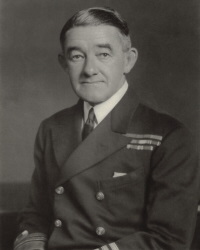Sidney Robert Bailey

Rank: Vice-Admiral
Joined Hood: 14th August 1934
Left Hood: 22nd July 1936
Biographical Information:
Sidney Robert Bailey was born on 27th August, 1882.
Joining H.M.S. Britannia in 1896 he first saw action in Seymour's expedition for the relief of Peking, in 1900, for which he received special promotion to Lieutenant and was mentioned in despatches.
1915 saw him joining H.M.S. Lion, Beatty's flagship, as Fleet Gunnery Officer. This was also the start of an ongoing association with Chatfield, (later Admiral of the Fleet, Lord Chatfield) who was Flag Captain in Lion at the time. Bailey was in Lion at the Battle of Jutland, 31st May, 1916, as part of Beatty's staff.
When Jellicoe became First Sea Lord late in 1916, Beatty took over as Commander in Chief of the Grand Fleet and brought both Chatfield and Bailey with him. Initially posted to Iron Duke, March 1917 saw them transfer to the new fleet flagship, the battleship Queen Elizabeth. Chatfield foresaw a role for Bailey in co-ordinating and the efforts of the fleet gunnery officers and ensuring a standardised approach was implemented.
Promoted to Captain in 1918 he went on to serve as Captain of H.M.S. Renown.
Having been promoted to Rear-Admiral, in 1931 he was appointed the following years as Chief of Staff to Chatfield who had then reached the rank of Admiral and held the post of Commander in Chief, Mediterranean.
In August 1934 Bailey joined H.M.S. Hood. At this time he was regarded as one of the Navy's leading experts in gunnery and still enjoyed the support of Chatfield who had risen to be First Sea Lord. He was also held in high regard by Admirals Dreyer and James - both former Hood Flag Officers. During 1935 came promotion to Vice-Admiral confirming that Bailey was still on course for high office. Then, during the spring exercises of 1935, came events that were to cast a shadow over Bailey's career and sour relations between the ships of the squadron. During the exercise Hood and Renown were initially to follow a parallel course some miles apart. On completion of the exercise they steered a converging course - Hood roughly West South West and Renown South South West. Bailey's intention had been for Renown to take position behind Hood in line astern, then for both ships to make a turn southward. However, on board Renown, Captain Sawbridge was under the impression that as he approached Hood, the flagship would turn southward to allow him to form up in line astern. As the ships drew closer to one another doubts entered the minds of those on both vessels. Then, as both realised a collision was possible, attempts were made to take avoiding action. Bailey, on board Hood, confirmed his intention by flag signal to Renown. The collision occurred and both ships were damaged, though no one was killed.
Courts-martial followed for Bailey and both Captains - Tower of Hood and Sawbridge of Renown. Sawbridge was blamed and stripped of command of Renown. Bailey and Tower were cleared. However the Admiralty took a different view and considered that although Sawbridge was partly to blame, so was Bailey as he had ordered the converging course and only belatedly made a signal to Renown confirming his intentions. Sawbridge was allowed to retain his command of Renown. The incident had done nothing to cement relations between the two crews and this was not rectified until after Bailey's time aboard Hood had ended. Indeed, some of his closest supporters, Chatfield amongst them, felt that Bailey could have done more to foster a spirit of reconciliation after the court-martial findings had been published.
Bailey continued to serve aboard Hood - mainly in the Mediterranean where she was used in an attempt to deter Italian aggression - until July 1936. He then returned to Portsmouth.
July 1937 saw Bailey promoted to Vice-Admiral Commanding Royal Naval College, Greenwich. His final promotion to Admiral came in 1939 the same year as his retirement. He died on 27th December 1942.
Image copyright, National Portrait Gallery (Used inder Licence, resized to 250x200px
Sir Sidney Robert Bailey
by Walter Stoneman
bromide print, July 1936
NPG x163818
Copyright National Portrait Gallery, London
Additional Photographs
None at this time.
No known memorials
Sources
Commonwealth War Graves Commission
'Register of Deaths of Naval Ratings' (data extracted by Director of Naval Personnel (Disclosure Cell), Navy Command HQ, 2009)
Chalmers, RADM W S: The Life and Letters of David Beatty, Admiral of the Fleet, (Hodder & Stoughton, 1951)
Chatfield, Admiral of the Fleet, Lord: The Navy and Defence (Heinemann, 1942)
Alan Coles and Ted Briggs: Flagship Hood, (Hale, 1985)
